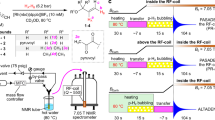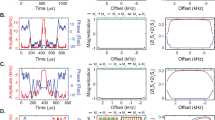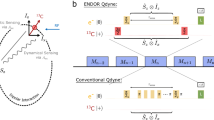Abstract
The precision of nuclear magnetic resonance spectroscopy1 (NMR) is limited by the signal-to-noise ratio, the measurement time Tm and the linewidth Δν = 1/(πT2). Overcoming the T2 limit is possible if the nuclear spins of a molecule emit continuous radio waves. Lasers2,3 and masers4,5,6,7,8,9,10,11,12,13 are self-organized systems which emit coherent radiation in the optical and micro-wave regime. Both are based on creating a population inversion of specific energy states. Here we show continuous oscillations of proton spins of organic molecules in the radiofrequency regime (raser5). We achieve this by coupling a population inversion created through signal amplification by reversible exchange (SABRE)14,15,16 to a high-quality-factor resonator. For the case of 15N labelled molecules, we observe multi-mode raser activity, which reports different spin quantum states. The corresponding 1H-15N J-coupled NMR spectra exhibit unprecedented sub-millihertz resolution and can be explained assuming two-spin ordered quantum states. Our findings demonstrate a substantial improvement in the frequency resolution of NMR.
This is a preview of subscription content, access via your institution
Access options
Access Nature and 54 other Nature Portfolio journals
Get Nature+, our best-value online-access subscription
$32.99 / 30 days
cancel any time
Subscribe to this journal
Receive 12 print issues and online access
$259.00 per year
only $21.58 per issue
Buy this article
- Purchase on SpringerLink
- Instant access to full article PDF
Prices may be subject to local taxes which are calculated during checkout




Similar content being viewed by others
References
Ernst, R. R., Bodenhausen, G. & Wokaun, A. Principles of Nuclear Magnetic Resonance in One and Two Dimensions (Clarendon Press, 1987).
Maiman, T. H. Stimulated optical radiation in ruby. Nature 187, 493–494 (1961).
Haken, H. Synergetics: An Introduction (Springer, 1983).
Ramsey, N. F. The atomic hydrogen maser. Metrologia 1, 7–15 (1964).
Townes, C. H. Nobel Lectures, Physics 1963–1970 58–86 (Elsevier, 1972).
Richards, M. G., Cowan, B. P., Secca, M. F. & Machin, K. The 3He nuclear Zeeman maser. J. Phys. B 21, 665–681 (1988).
Gilles, H., Monfort, Y. & Hamel, J. 3He maser for Earth magnetic field measurement. Rev. Sci. Instrum. 74, 4515–4520 (2003).
Chupp, T. E., Hoare, R. J., Walsworth, R. L. & Wu, Bo. Spin-exchange-pumped 3He and 129Xe Zeeman Masers. Phys. Rev. Lett. 72, 2363–2366 (1994).
Bösiger, P., Brun, E. & Meier, D. Solid-state nuclear spin-flip maser pumped by dynamic nuclear polarization. Phys. Rev. Lett. 38, 602–605 (1977).
Chen, H. Y., Lee, Y., Bowen, S. & Hilty, C. Spontaneous emission of NMR signals hyperpolarized proton spin systems. J. Magn. Reson. 208, 204–209 (2011).
Zhuravlev, A. G., Berdinskiǐ, V. L. & Buchachenko, A. L. Generation of high-frequency current by the products of a photochemical reaction. JETP Lett. 28, 140–142 (1978).
Oxborrow, M., Breeze, J. D. & Alford, N. M. Room-temperature solid-state maser. Nature 488, 353–356 (2012).
Jin, L. et al. Proposal for a room-temperature diamond maser. Nat. Comun. 6, 8251 (2015).
Adams, R. W. et al. Reversible interactions with para-hydrogen enhance NMR sensitivity by polarization transfer. Science 323, 1708–1711 (2009).
Green, A. G. et al. The theory and practice of hyperpolarization in magnetic resonance using parahydrogen. Prog. Nucl. Magn. Reson. Spec. 67, 1–48 (2012).
Adams, R. W., Duckett, S. B., Green, R. A., Williamson, D. C. & Green, G. G. R. A theoretical basis for spontaneous polarization transfer in non-hydrogenative parahydrogen-induced polarization. J. Chem. Phys. 131, 194505 (2009).
Appelt, S. et al. Theory of spin-exchange optical pumping of 3He and 129Xe. Phys. Rev. A 58, 1412–1439 (1998).
Carver, T. R. & Slichter, C. P. Experimental verification of the Overhauser nuclear polarization effect. Phys. Rev. 102, 975–981 (1956).
Suefke, M., Liebisch, A., Blümich, B. & Appelt, S. External high-quality-factor resonator tunes up nuclear magnetic resonance. Nat. Phys. 11, 767–771 (2015).
Lichter, L. R. & Roberts, J. 15N nuclear magnetic resonance spectroscopy. XIII. Pyridine 15N. J. Am. Chem. Soc. 93, 5218–5224 (1971).
Allerhand, A., Addleman, R. E. & Osman, D. Ultrahigh resolution NMR. 1. General considerations and preliminary results for carbon-13 NMR. J. Am. Chem. Soc. 107, 5809–5812 (1985).
Appelt, S., Kühn, H., Häsing, F. W. & Blümich, B. Chemical analysis by ultrahigh-resolution nuclear magnetic resonance in the Earth’s magnetic field. Nat. Phys. 2, 105–109 (2006).
McDermott, R. et al. Liquid-state NMR and scalar couplings in microtesla magnetic fields. Science 295, 2247–2249 (2002).
Theis, T. et al. Parahydrogen-enhanced zero-field nuclear magnetic resonance. Nat. Phys. 7, 571–575 (2011).
Heil, W. et al. Spin clocks: probing fundamental symmetries in nature. Ann. Phys. 525, 539–549 (2013).
Blümich, B., Casanova, F. & Appelt, S. NMR at low magnetic fields. Chem. Phys. Lett. 477, 231–240 (2009).
Humphrey, M. A. et al. Testing CPT and Lorentz symmetry with hydrogen masers. Phys. Rev. A 68, 063807 (2003).
Pospelov, M. & Romalis, M. Lorentz invariance on trial. Phys. Today 57, 40–46 (July, 2004).
Cowley, M. J. et al. Iridium N-heterocyclic carbene complexes as efficient catalysts for magnetization transfer from para-hydrogen. J. Am. Chem. Soc. 133, 6134–6137 (2011).
Acknowledgements
S.A. thanks the late C. H. Townes for inspiring discussions in Berkeley during autumn 2011. The authors gratefully acknowledge excellent technical assistance and financial support from S. van Waasen, R. Eichel and A. Schwaitzer from the Jülich Research Center and P. Schleker from RWTH Aachen University for help with respect to SABRE chemistry. Furthermore, we would like to thank I. Kalf for supplying deuterated pyridine, and greatly acknowledge J. A. Reimer from UC Berkeley for inspiring discussions and corrections.
Author information
Authors and Affiliations
Contributions
M.S. built the hardware for EHQE-NMR and para-hydrogen technology, performed experiments, and wrote software for data analysis. S.L. prepared optimized SABRE samples and conducted experiments. A.L. performed experiments and analysed experimental results. B.B. provided laboratory and experimental facilities and creative input. S.A. supervised the project, performed experiments, analysed experimental results, developed the theoretical framework and wrote software for simulation of NMR spectra. M.S., S.L., A.L., B.B. and S.A. wrote the paper.
Corresponding author
Ethics declarations
Competing interests
The authors declare no competing financial interests.
Supplementary information
Supplementary information
Supplementary information (PDF 1349 kb)
Rights and permissions
About this article
Cite this article
Suefke, M., Lehmkuhl, S., Liebisch, A. et al. Para-hydrogen raser delivers sub-millihertz resolution in nuclear magnetic resonance. Nature Phys 13, 568–572 (2017). https://doi.org/10.1038/nphys4076
Received:
Accepted:
Published:
Issue date:
DOI: https://doi.org/10.1038/nphys4076
This article is cited by
-
Achieving 5% 13C nuclear spin hyperpolarization in high-purity diamond at room temperature and low magnetic field
Scientific Reports (2025)
-
Feedback-induced nonlinear spin dynamics in an inhomogeneous magnetic field
Communications Physics (2025)
-
Through-bond and through-space radiofrequency amplification by stimulated emission of radiation
Communications Chemistry (2024)
-
What Happened
Applied Magnetic Resonance (2023)
-
Approaching the Ultimate Limit in Measurement Precision with RASER NMR
Applied Magnetic Resonance (2023)



